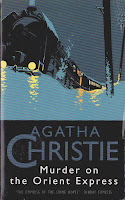My goodness, there are a lot of books that have been given the ol' film treatment. Actually, they call the film version of a book a "treatment" - sounds like it's having something removed, don't you think?
Well, the challenge wasn't to watch the movie, just read a book, so if you didn't want to experience the favourite parts of your book end up on the cutting room floor, you didn't have to. Bonus points, however, will be awarded to anyone who not only read the book, but also watched the film. Extra bonus points if you watched more than one version.
We aren't actually giving any points, by the way - these are purely for your own records.
Brenda Carter read Doctor Zhivago, by Boris Pasternak.
Well, the challenge wasn't to watch the movie, just read a book, so if you didn't want to experience the favourite parts of your book end up on the cutting room floor, you didn't have to. Bonus points, however, will be awarded to anyone who not only read the book, but also watched the film. Extra bonus points if you watched more than one version.
We aren't actually giving any points, by the way - these are purely for your own records.
Brenda Carter read Doctor Zhivago, by Boris Pasternak.
You can
find both the book (891.7 PAS 2C DOC) and the film (791.4372
DOK) of my recommended title for this week, Doctor Zhivago by Boris Pasternak, in the JCU library.
The 1965
classic film ranks alongside Gone with the Wind and The English Patient for
its tragic love story set amidst political turmoil, and for its sweeping
cinematography. Don’t read the novel for romance, though – the story of Zhivago
and Lara is a minor part of the book, which is largely given over to
Pasternak’s reflections on Russian society and politics before, during and
after the Russian revolution and Civil War, expressed through the voices of his
characters and narrative monologues.
Amongst the change, violence and confusion
of these times, the characters struggle to adapt and survive.
Sounds grim? It’s
a great novel for gaining perspective if you think you’ve had a bad day, and a
thorough introduction to a period of Russian history and culture.
Rachael McGarvey read Twelve Years a Slave, by Solomon Northup.
Twelve Years a Slave (305.5670973 NOR) is a memoir based on true accounts by Solomon Northup, who was living as a free man in New York and kidnapped while in Washington DC, smuggled to Louisiana and sold into slavery.
At the time his family (his wife and children) had no idea what happened to him. During his time as a slave Northup had been sold to several slave owners and endured unimaginable cruelty.
Eventually Solomon was able to get a letter to his family and with the help of a family friend who travelled to Louisiana to find him was freed and returned to his family.
This was not an easy book to read and Solomon’s firsthand accounts of slavery and how the people working on the plantations were treated are quite confronting and a little hard to forget.
Sharon Bryan read Murder on the Orient Express, by Agatha Christie.
So, my challenge is to write a review about a mystery novel (which you'll find at 820 CHR 1C MUR/HAR) without revealing any spoilers for the three people in the world who might not have already heard how this ends. Wish me luck.
The great (even if he does say so himself) Hercule Poirot is called back to England in a hurry, and must catch a train that seems unusually full for this time of year. Fortunately, he's friends with the guy who runs the rail company, and that guy just happens to be catching the same train.
Unfortunately, the train gets snowed in somewhere in the middle of Yugoslavia.
Fortunately (?), everyone is kept occupied by the untimely death of one of the passengers, who has most definitely been murdered. But nothing about this case makes any sense. The victim has been stabbed twelve times - but the same person can't be responsible for all of the stab wounds, and some of the wounds were inflicted after the man had been dead for some time. Could there be more than one murder?
And everyone on the train has someone who can vouch for them at the time of the murder, but the murderer couldn't have left the train because of the snow... Then there's the mysterious woman in the red kimono, and the small man with the womanish voice. Who are these people? Where do they fit in?
Essentially, we have a locked room mystery, only the room is a train and it's full of people. Can the great Poirot find the solution? Can a fish swim?
Oh, and we don't have the most recent movie version yet, but we do have the old one starring Albert Finney as Poirot. You'll find it at 791.4372 MUR.



Comments